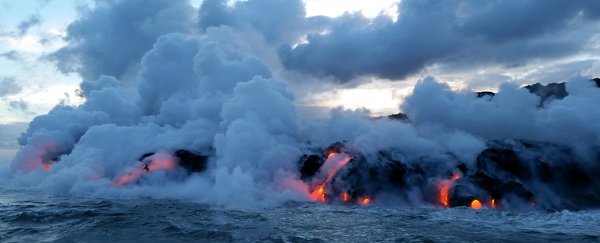None of us would be around if organisms hadn't been sparked into life billions of years ago. The question of just how that spark came about continues to fascinate scientists.
New research looking at how the conditions on primordial Earth might have produced life has identified a mixture of salts that, mixed with heat flows from molten rock, could potentially have contributed to the formation of self-replicating biomolecules.
This self-replication is a key part of the 'RNA world' hypothesis: the idea that ribonucleic acids (RNA) can both store biological information and perform the required structure folding for life to grow and evolve into the state it is today.
In this case, scientists looked at the mixture of magnesium (Mg) and sodium (Na) as it might have been on Earth in its earliest years: for RNA folding to work, a relatively high concentration of doubly charged magnesium ions and a lower concentration of singly charged sodium is required.
"Accordingly, the question arises as to which environments on early Earth might have provided suitable salt conditions for such prebiotic processes. One geologically probable process that produces saline environments is the leaching of salts from basalt," the international team of researchers writes in their study.
"As a primary partial melt of the Earth's mantle, basalt is one of the most abundant rock types to be expected in the Earth's early crust, as well as the crust of other terrestrial planets in our Solar System."
The team synthesized basaltic glass – which naturally occurs on Earth when melted basalt is rapidly cooled (by contact with ocean water, for instance) – and characterized it in its various forms, including both rock and glass.
An analysis of the amount of magnesium and sodium extracted from the glass, under a variety of temperatures and with a variety of grain sizes, always showed significantly more sodium than magnesium.
What's more, the levels of magnesium were always significantly lower than necessary for prebiotic RNA folding to properly function. The missing part of the process, the researchers discovered, was convective flows of heat.
"This situation changed considerably when heat currents – which are very likely to have been present, owing to the high levels of geological activity expected in prebiotic environments – were added," says biophysicist Christof Mast, from the Ludwig Maximilians University of Munich in Germany.
"We have shown that a combination of basaltic rocks and simple convection currents can give rise to the optimal relationship between Mg and Na ions under natural conditions."
The temperature gradients that feature in the narrow cracks and pores of basaltic glass create the convective flows required for salt optimization and also move more ions against the current – creating what's known as thermophoresis.
Together, convection and thermophoresis increase the number of magnesium ions in the mix, creating conditions where self-replicating RNA can occur, the study shows. The same sort of chemical reactions may have played out on Earth 4 billion years ago.
This leaching of salts from basalt – found in abundance in Earth's mantle – fits the template for the RNA world hypothesis to work, the research shows. What's more, it widens out the possibilities in terms of salt mixes that may have helped spark life.
"The principle demonstrated here is applicable to a broad range of salt concentrations and compositions, and, as such, highly relevant to various origin-of-life scenarios," write the researchers in their published paper.
The research has been published in Nature Chemistry.
